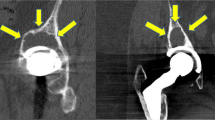Abstract.
Between 1991 and 1994, 147 patients (154 hips) underwent a primary cemented total hip replacement using the Ultima ti-alloy, collarless, double-tapered stem and a UHMWPE cup. The average age at operation was 66.4 years. Ninety-one patients (97 hips) were available for review with an average follow-up of 76 months. The Harris hip score had improved from pre-operative average of 43.1 (12.5–65.0) to the latest score of 88.9 (67.5–100). There were 11 revisions in total, eight of which were for aseptic stem loosening. The results of Kaplan-Meier survival analysis, based on stem revision for aseptic loosening as an end-point, was 92% at 8 years. Early stem migration analysis at 2 years was possible in 114 cases using digitised radiographs analysed by the EBRA method. Sixty-three stems had not migrated and 35 migrated less than 2 mm with only one of these ending in failure. Sixteen stems showed early migration of more than 2 mm and five of these failed. Early stem migration is predictive of stem failure. Osteolytic lesions occurred in 12 femurs and four of these stems failed.
Résumé.
Entre 1991 et 1994, 147 malades (154 hanches) ont subi une arthroplastie primaire cimentée qui utilise une tige à section décroissante Ultima sans collerette en alliage de Titane et une cupule de UHMWPE. L'âge moyen à l'opération était 66.4 ans. Quatre-vingt-onze malades (97 hanches) étaient disponibles pour la révision avec une moyenne de suivi de 76 mois. Le score de Harris s'est amélioré de la moyenne préopératoire de 43.1 (12.5 à 65.0) au score le plus tardif de 88.9 (67.5 à 100). Il y avait 11 révisions, huit pour descellement aseptique de la tige. La survie selon Kaplan-Meyer, basée sur la révision de la tige pour descellement aseptique était 92% à huit années. L'analyse du descellement précoce de la tige à deux années était possible dans 114 cas utilisant des radiographies digitalisées analysées par la méthode EBRA. Soixante-trois tiges n'avaient pas migré et trente-cinq tiges avaient migré de moins de 2 mm avec seul cas évoluant vers un échec. Seize tiges ont montré une migration de plus de 2 mm avec finalement cinq échecs. La migration précoce de la tige est prédictif du descellement. Les lésions ostéolytique se sont produites sur 12 fémurs conduisant à quatre échecs par descellement fémoral.
Similar content being viewed by others
Author information
Authors and Affiliations
Additional information
Electronic Publication
Rights and permissions
About this article
Cite this article
Meek, D.R., Michos, J., Grigoris, P. et al. Mid-term results and migration behaviour of a ti-alloy cemented stem. International Orthopaedics (SICOT) 26, 356–360 (2002). https://doi.org/10.1007/s00264-002-0386-9
Accepted:
Issue Date:
DOI: https://doi.org/10.1007/s00264-002-0386-9




